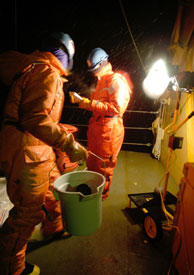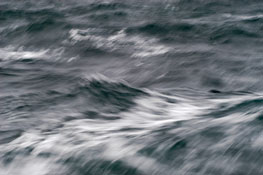 |
 |
 |
| Carin Ashjian (left) holds a bucket containing the net tow sample while Martha Delaney (right) takes notes. |
| Click
to enlarge |
Daily Update
Calendar
Dispatch 17 - September 26, 2003
By C. A. Linder
Weather conditions: Overcast skies, blowing snow, 30 kt winds
gusting to 40 knots, 5-7 ft seas, air temperature 28°F
Weather Day
Our calm weather ended late last night as a fierce polar low slammed
the Beaufort Sea. My alarm jarred me awake at 4AM - time to photograph
a night net tow. My sleep-addled brain was blasted awake as I stepped
out onto the weather deck. Whoah, that's refreshing! I made my way
back to the fantail where the net tow crew was standing ready. As
the ship maneuvered into position, the wind raked across the deck.
The snow wasn't accumulating much since it was blowing horizontally.
This was going to be an interesting net tow.
Carin Ashjian describes the evolution: "It
was blowing about 20 knots so we had to be careful that the net
didn't get away from us. It was great to have four of us out there,
since there were plenty of hands to hang on! For some reason, it
always snows during the net tows. We didn't raise the net too high,
so that the wind couldn't catch it. Everything went really well,
from the ship handling to the winch driving to the deck work and
it was a very successful tow."
The wind continued to build today, gusting to 40 knots at times.
The winds whipped up the waves, and the ship started rocking for
the first time since our first day out from Barrow. Although we
aborted our mooring recovery plans, we managed to get some other
important tasks done. John Kemp confirmed
the location of the Acoustic
Recording Package (ARP) that we deployed
last year. Lisa Munger also got two ARPs ready for deployment,
installing the lithium batteries. Sarah Zimmermann, Dan Torres,
and Ryan Schrawder continued to extract data from the mooring instruments. Ryan
even got a haircut!
 |
 |
| Winds gusting to 40 knots whipped the waves into a confused frenzy. |
| Click
to enlarge |
Mrs. Werner's 6th grade class at the Morse
Pond School has two excellent questions.
Question: What is the thickest ices the cutter has cut through?
Answer: The Operations Officer, Lieutenant Commander
Daryl Peloquin, helped me out with the answer to this question. He
showed me some summary documents from the Healy's ice trials
in Spring 2000. This is when Healy first tested her strength
against the Arctic icepack.
The tests were a success. It was confirmed that Healy could
break flat ice 6 feet thick continuously under full power (30,000
horsepower) at a speed of 5 knots. The ship's icebreaking power was
then tested against a pressure ridge. A pressure ridge results when
two slabs of ice collide, forming a thick layer where the plates meet.
The portion of a ridge extending above the water is called a sail,
and the portion below the water is called a keel. It this case the
ridge they selected was 46 feet thick from sail to keel - as tall
as a two-storey house! This quote from the ice trials summary document
describes the operation: "After making sure that the data from
all transducers were being recorded, we moved the ship ahead in thin
ice towards the middle of the ridge under full power (29,500-30,000
HP)... During the first ram, the ship stopped in the ridge after the
bow went over the sail and depressed it down. We backed the ship and
rammed forward again at a speed of 7.5 kt to advance a distance of
44 m. After another similar operation, the aft of the ship cleared
the ridge completely, as is evident from the increasing ship speed
at the end of the test." Backing and ramming is a technique icebreakers
use against very thick ice. The trials determined that the ship can
advance about a quarter mile per hour through 11 foot thick multi-year
ice.
Question: How different is this trip from last year?
Answer: This trip is different from last year in
many ways. The most important difference is that our objectives are
different. Last year our mission was to deploy the moorings and conduct
a CTD survey. This year we are recovering the moorings, then redeploying
all of them. We are also conducting CTD surveys, collecting shipboard
bathymetry and current data, and performing net tows and Video Plankton
Recorder casts! As opposed to last year's small (11 people) science
party, this year there are 20 of us. We have a much broader spectrum
of oceanographers, including biologists and acousticians. Finally,
the most striking difference to me is the environment. What a difference
a few months makes! The ice we fought last year in July and August
is all but absent here in September. We may also get to see sea-ice
forming in late October as the winter chill sets in.
Our plans for tomorrow are the same as they were for today... assuming
the weather improves! We are all hoping that the storm passes quickly
and leaves us calm seas so we can finish the mooring recoveries.
 Previous
Dispatch Next Dispatch Previous
Dispatch Next Dispatch

Back to
Calendar
|




